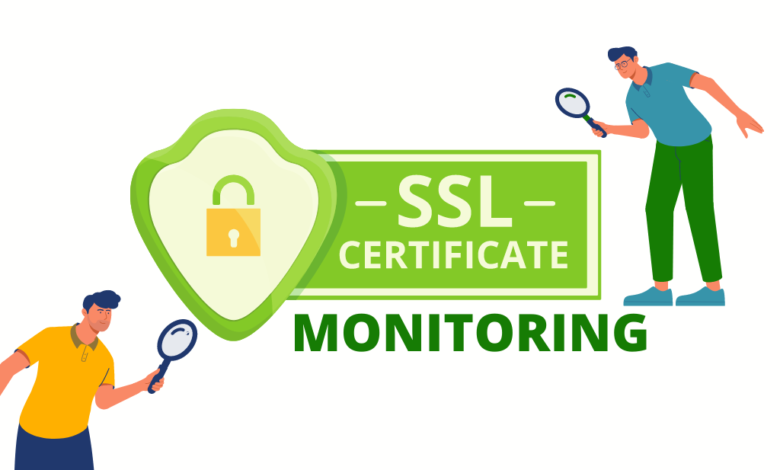Keep Your Site Secure with Automated SSL Monitoring

In today’s digital world, security is everything especially for websites that handle user data, logins, or online transactions. One of the simplest yet most powerful tools for maintaining that security is SSL Monitoring.
Whether you run a small blog or a large e-commerce site, failing to maintain your SSL certificate can lead to browser warnings, lost trust, and even legal trouble. But with automated monitoring, you can avoid these problems entirely.
Let’s break down how SSL monitoring works, why it’s essential, and how you can implement it effortlessly.
What Is an SSL Certificate?
An SSL (Secure Sockets Layer) certificate is a digital file that encrypts data sent between your website and your visitors’ browsers. When active, it turns your URL from http:// to https://, adds the lock icon in the browser, and protects sensitive information like passwords, credit card details, and form submissions.
Without it, visitors may receive a warning saying your site is “not secure, which can destroy trust and hurt your traffic.
Why SSL Certificates Expire
Like most security protocols, SSL certificates are time-limited. Most are valid for 90 days to 1 year and need to be renewed manually or automatically. If they expire without renewal, your site immediately becomes untrusted by browsers.
Unfortunately, many site owners forget to renew SSL certificates on time. Even a few hours of downtime can hurt SEO, user experience, and customer confidence.
What Is SSL Monitoring?
SSL Monitoring is a system that checks the status of your SSL certificate 24/7. It alerts you when:
Your certificate is about to expire
There are configuration issues
A certificate is missing or invalid
The SSL chain is broken
It fails to load over HTTPS
With proper monitoring, you don’t have to remember renewal dates or worry about unexpected security lapses. You’ll receive alerts via email, SMS, or your dashboard well before the expiry date, giving you time to act.
Why Is SSL Monitoring Important?
1. Avoid Website Downtime
When your SSL certificate expires, visitors will see a full-page browser warning. Many will leave immediately. This loss of traffic hurts your brand, sales, and engagement. SSL monitoring ensures that doesn’t happen.
2. Protect Sensitive Data
If your SSL fails, your site could expose user data to hackers. Monitoring keeps you ahead of potential breaches by identifying problems before users are affected.
3. Preserve Customer Trust
Most users don’t understand the technical details of SSL. But they do recognize the lock icon. The moment it disappears, they start doubting your credibility. Consistent SSL performance keeps your image strong and professional.
4. Boost SEO
Google uses HTTPS as a ranking signal. Expired or broken SSL certificates negatively affect your search visibility. Monitoring helps you stay compliant with Google’s quality standards.
5. Compliance with Regulations
If your site handles user data, payment details, or health records, you may be legally required to maintain strong SSL protocols. Monitoring supports regulatory compliance like GDPR, PCI DSS, and HIPAA.
Real-Time Alerts Save the Day
Manual checks aren’t practical, especially if you manage multiple domains or subdomains. Automated SSL monitoring checks your certificates every few minutes. If a problem is detected like a mismatch, wrong hostname, or invalid chain you’ll be notified instantly.
This gives you enough time to fix the issue before it causes user impact or reputational harm.
Use Cases for SSL Monitoring
SSL Monitoring isn’t just for large businesses. It’s critical in many scenarios:
E-commerce stores: To secure online transactions
Membership sites: To protect login details
Healthcare websites: For HIPAA compliance
Finance and banking portals: To ensure encryption
Educational platforms: For secure user data
SaaS products: For smooth and trusted access
Whether you’re running one site or managing hundreds, automated SSL Monitoring provides peace of mind and round-the-clock protection.
Features to Look For in an SSL Monitoring Tool
When choosing a monitoring service, ensure it offers:
Real-time monitoring (every minute or hour)
Advance expiry alerts (30/15/7 days before)
Multi-domain support
Notification options (email, SMS, webhook)
Public or private dashboards
Easy-to-read reports
International certificate support
Compatibility with wildcard and EV certificates
The tool should also provide a simple setup process, no complicated coding or system admin skills needed.
Read Also: Why You Should Always Choose a Company That Offers Complete Plumbing Services
How to Set Up SSL Monitoring in Minutes
Most modern platforms let you get started in three simple steps:
Add your website URL
Select SSL monitoring options
Set up notification preferences
Once active, the tool will keep an eye on your SSL certificate 24/7 and alert you to any problems instantly.
Common SSL Problems Monitoring Helps Prevent
Expired Certificates: Catches them before expiry
Self-Signed Certificates: Detects untrusted sources
Wrong Domain: Alerts if your certificate doesn’t match your site
Broken SSL Chains: Warns of misconfigurations in the trust path
Mixed Content: Notifies if some elements of your page aren’t secure
Catching these early ensures your users never encounter browser errors or warnings when visiting your site.
Final Thoughts
Securing your website with an SSL certificate is no longer optionalit’s the standard. But having an SSL certificate isn’t enough. You need to maintain it consistently and ensure it’s always valid.
That’s where SSL Monitoring becomes crucial. It automates the process, sends timely alerts, and helps you avoid damaging downtime or user mistrust. Whether you run a personal blog, business site, or enterprise platform, monitoring your SSL is a simple step with big security payoffs.





